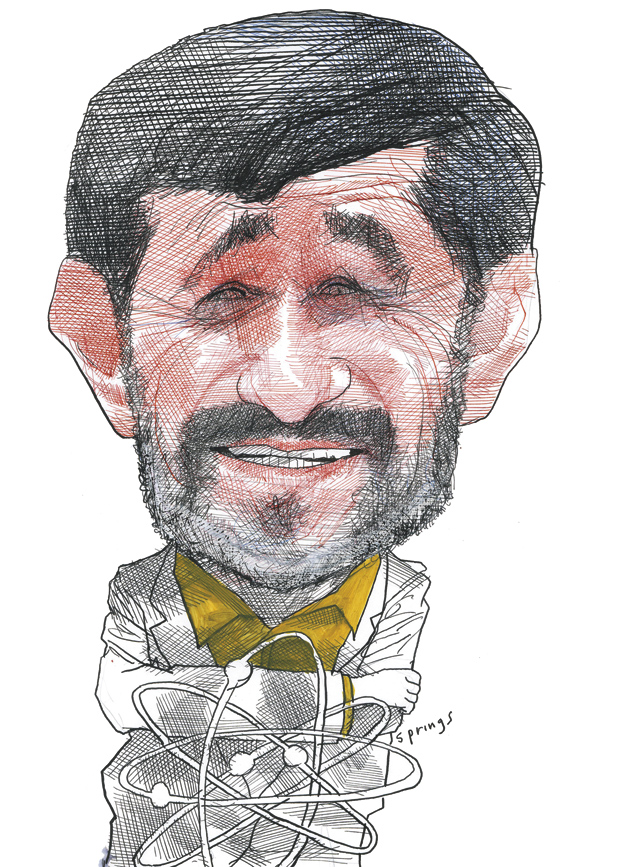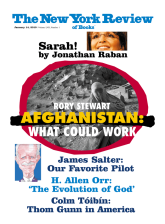To Western officials who have spent months trying to slow down Iran’s nuclear program, Mahmoud Ahmadinejad’s announcement on November 29 of plans to build ten new uranium enrichment plants is deeply unsettling. But the real worry may be the nuclear facilities already in existence. In mid-November, Russian Energy Minister Sergei Shmatko announced that, for “technical reasons,” the Russians would not finish in 2009 the reactor they are constructing for the Iranians at Bushehr on the Persian Gulf. Although Russia has since reaffirmed its commitment to completing the reactor, the specific reasons for the delay were not given, so one may speculate that, despite Russian denials, this was a message of displeasure sent to the Iranians.
There is much to be displeased about. After years of intransigence during the Bush administration, the Iranian government indicated to the UN Security Council in early October that it would open its nuclear program to international inspectors and would export 1,200 kilograms of its low-enriched uranium—the bulk of its current supply—to Russia for processing. But it has since failed to formalize the agreement, while expanding its enrichment activities inside Iran. On December 12, the Iranian government said it was prepared to send abroad four hundred kilograms of low-enriched uranium, a much smaller amount, in exchange for nuclear fuel, but the US dismissed the offer as inconsistent with the original UN deal. Meanwhile, reports have surfaced that—if accurate—suggest that Iran may be working on a neutron generator, or trigger, for use in a nuclear weapon; and Obama administration officials have been calling for strong new sanctions against Iran.
One can make the case that the Bushehr reactor will be used for generating electricity, but no such case can be made for the reactor located at Arak in central Iran. While the Arak reactor is not powerful enough to generate meaningful amounts of electricity, it is far more powerful than is necessary to simply make medical isotopes—which the Iranians claim is its intended purpose. In fact, this reactor is suited to manufacture plutonium; it is a type that has been used in weapons programs in countries such as India and Israel.
During an August, 2009, visit to Arak, the International Atomic Energy Agency (IAEA) inspectors were not able to verify whether the Iranian regime has the auxiliary equipment—for example, the so-called hot rooms—needed to separate plutonium from the reactor’s highly radioactive fuel elements. It is not certain when this reactor will go into operation but its existence raises questions that Iran has not satisfactorily answered.
Meanwhile, the centrifuge facility in Natanz is now operating with 3,936 P-1 centrifuges—the original type created with the help of A.Q. Khan, the Pakistani metallurgist and proliferator. There are, according to the IAEA, 4,456 additional centrifuges in the plant that are not yet operating for reasons unknown. Why is this worrisome?
So far, the Natanz facility has produced some 1,700 kilograms of low-enriched uranium hexafluoride. This contains about forty kilograms of uranium 235, which is the isotope of uranium that is fissioned in a reactor. The thing to emphasize is that this amount is far too little to power the Bushehr reactor, or any reactor intended to produce electric power, which would require something like eight hundred kilograms a year of uranium 235. In fact, the Russians were going to supply the Bushehr reactor with enough Russian-produced low-enriched uranium to operate, and the Arak reactor uses natural unenriched uranium.
The only purpose one can imagine, then, for producing low-enriched uranium at Natanz would be to further enrich it to obtain uranium 235. If the uranium that has been produced at Natanz were enriched to the point that 20 percent of it were uranium 235, it could be used to power the research reactor at Tehran University. If it were clandestinely enriched to 95 percent, it could be used in one or two weapons.
In this regard, the most troubling development is Iran’s disclosure in late September of a heretofore clandestine centrifuge plant near the city of Qom. The IAEA inspectors found this facility to be in an advanced state of preparation for the installation of some three thousand centrifuges. If these are of the new carbon fiber type, they will have twice the separative capacity of the P-1 centrifuges at Natanz—allowing them to enrich uranium much more rapidly. Depending on how these centrifuges are configured, the Qom plant could enrich enough uranium for two or more bombs a year. There is little doubt that the Iranians purchased the plans for a nuclear device from A.Q. Khan around the late 1980s. But with or without such plans the Iranians are quite capable of making their own bomb.

Now the Iranian government has announced plans to build ten more enrichment facilities, each involving tens of thousands of centrifuges. IAEA inspectors have never been allowed to visit the plants where Iran is manufacturing its centrifuges, but it is very unlikely that the Iranians have the carbon fiber or other materials needed to build the quantity of centrifuges required for these planned facilities. Their supply of uranium is also not unlimited.
Advertisement
In my view the real immediate danger is at Natanz. Here is the issue: there are mumblings from Tehran that Iran might pull out of the nonproliferation treaty and begin enriching uranium to higher levels. Depending on the sophistication of the design, you need between eighteen and thirty kilograms of uranium 235 to make a bomb. The uranium hexafluoride gas at Natanz, from which the uranium 235 would be extracted, has now been enriched to about 3.5 percent uranium 235.
The quickest way to enrich this to the approximately 90 percent required for a bomb is what is called “batch recycling”: the existing stock of low- enriched uranium is recycled a few times through the centrifuge cascade, acquiring a higher percentage of uranium 235 with each cycle. Using this method, the 1,700 kilograms of low-enriched uranium now available at Natanz could produce enough uranium 235 to make one bomb in as little as six months.
As a cover for such a plan, the Iranians could claim that they are enriching only to the 20-percent level needed for the Tehran research reactor. But once this genie is out of the bottle, what would stop them from going all the way? So the question is, do they have enough low-enriched uranium to make the eighteen to thirty kilograms of uranium 235 that, depending on the sophistication of the design, are needed to make a bomb? It would appear that they do. Whether they have missiles that can deliver a bomb is an open question so far as I know.
In an interview in early December, Mohamed ElBaradei, the retiring director general of the International Atomic Energy Agency, expressed a somewhat different view about Iran’s nuclear intentions. ElBaradei, who has had as much experience with the Iranians as anyone, believes, it seems, that the Iranians want to go far enough to persuade everyone that they have “the capacity to develop nuclear weapons in a few weeks or months” but that they do not actually want to make them. They want to have such a capacity, he thinks, because they believe it will allow them to bargain with the United States as equals.
If this is the case, a challenge for the Iranians—among other problems—is how do they convey that message? Do they say, for example, “Yes, A.Q. Khan sold us plans for a nuclear weapon but we are not pursuing them”? Or, “Yes, we can make enough highly enriched uranium to make a bomb in six months but we are not going to do so”? How can other nations believe this and how can they base a policy on it? Perhaps Mr. ElBaradei will have something to say about these questions.
Meanwhile, Iran continues to behave defiantly. The IAEA inspectors received documents as early as May 2008 that purport to show plans for a possible nuclear test site in a deep shaft. Iranians have declared that the documents are fake. On December 2 the Preparatory Commission for the Comprehensive Nuclear-Test-Ban Treaty Organization, a United Nations group, announced that it has built a site in Turkmenistan, a few miles from the Iranian border, to measure seismic signals—the kind that an exploding nuclear device gives off. A few days later the Iranians denounced the building of this station, one of some 250 in the world, as an attempt to spy. If the Iranians really have no intention of making nuclear weapons, why should they care?
—December 17, 2009
(A version of this article was published on the NYR blog, blogs.nybooks.com)
This Issue
January 14, 2010




